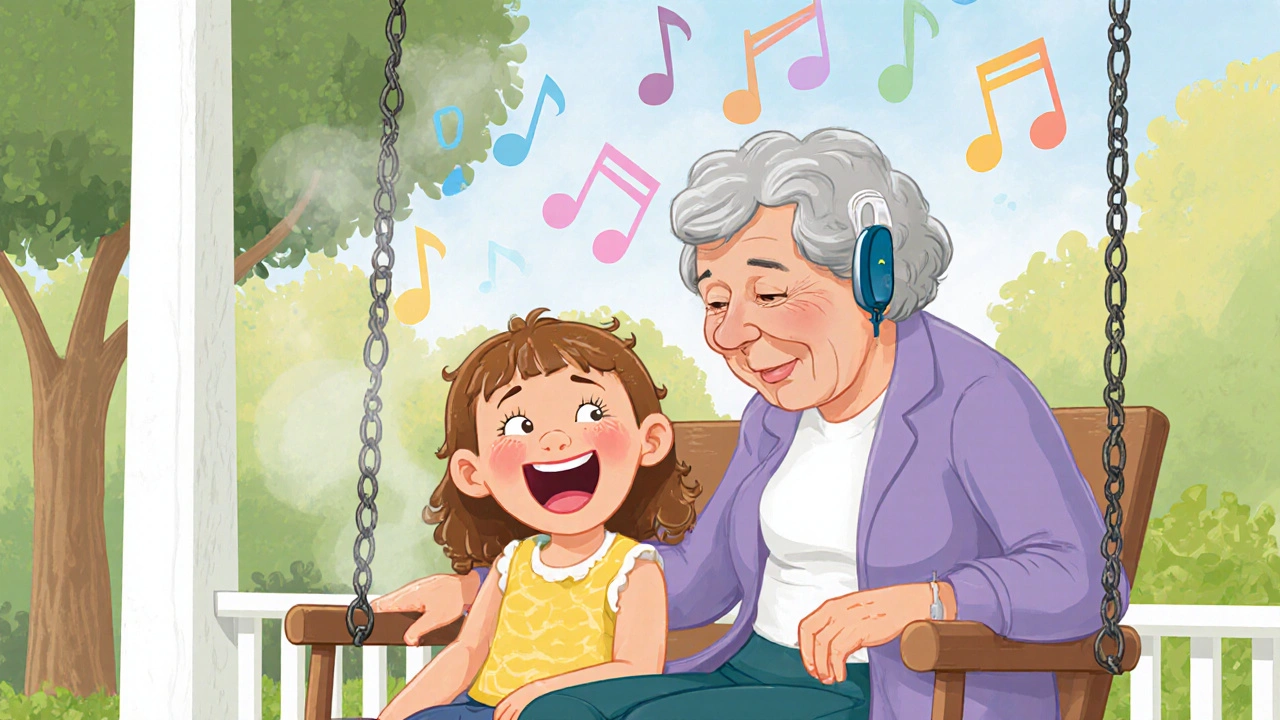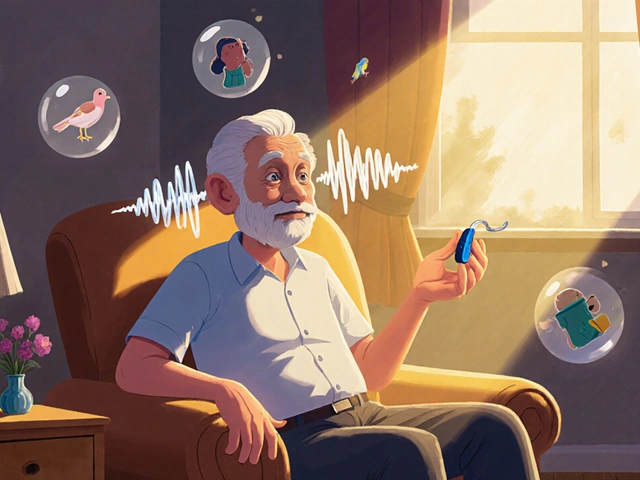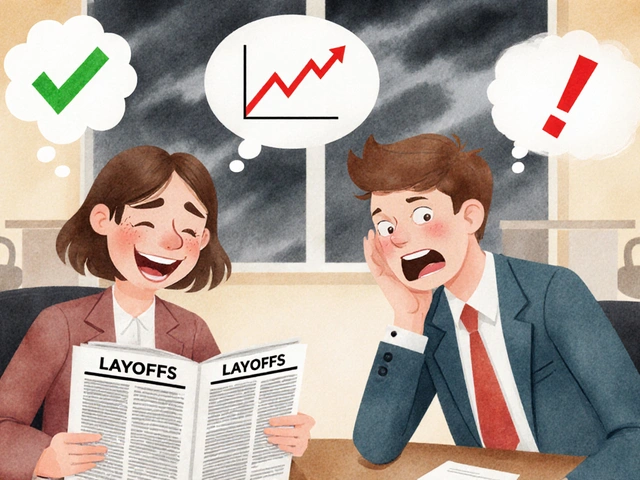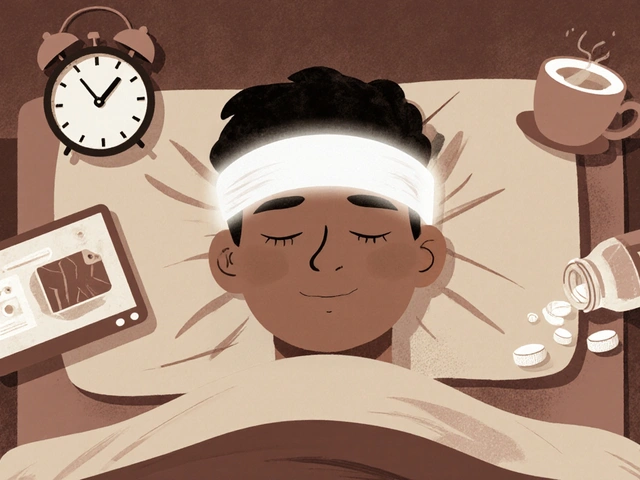17
Age-Related Hearing Loss: Understanding Presbycusis and Effective Amplification Strategies

By the time you turn 65, there’s a one-in-three chance you’re already struggling to hear conversations clearly. Not because you’re not paying attention, but because your ears are changing - slowly, silently, and without warning. This isn’t just about turning up the TV. It’s presbycusis, the medical term for age-related hearing loss, and it affects more than 37 million Americans. Unlike sudden hearing loss from noise or injury, presbycusis creeps in over decades, stealing high-pitched sounds first - your granddaughter’s laugh, the beep of a smoke alarm, the ‘s’ and ‘th’ in words like ‘sun’ or ‘think.’
What Exactly Is Presbycusis?
Presbycusis isn’t just ‘getting older.’ It’s a specific type of sensorineural hearing loss caused by damage to the inner ear’s hair cells. You’re born with about 16,000 of these tiny sensory cells in your cochlea. They don’t regenerate. Starting around age 30, you lose roughly 1% per year. By 70, many people have lost 40% or more. That’s why voices sound muffled, especially in noisy rooms. Speech doesn’t disappear - the high-frequency consonants do. You hear someone talking, but you can’t make out what they’re saying.
Genetics play a big role too. If your parents or grandparents had trouble hearing later in life, you’re more likely to. But it’s not all in your genes. Long-term exposure to loud noises - construction, lawn mowers, concerts - adds up. Smoking raises your risk by 15%. Diabetes and high blood pressure? They cut off blood flow to the inner ear, speeding up damage. The World Health Organization says cumulative noise exposure over 85 decibels for more than 8 hours a day increases your chance of presbycusis by 40%.
How Do You Know If It’s Presbycusis?
It’s easy to dismiss. ‘I’m just tired.’ ‘The TV’s too quiet.’ ‘Everyone mumbles.’ But here are the real signs:
- You need the TV volume louder than normal - often above 65 decibels (the level of a regular conversation).
- You keep asking people to repeat themselves, especially in restaurants or group settings.
- You struggle to hear children or women’s voices - they speak in higher pitches.
- You hear ringing or buzzing in your ears (tinnitus), which affects nearly 60% of people with presbycusis.
- You avoid social events because listening feels exhausting.
- You’ve missed alarms, doorbells, or car horns - and that’s not just forgetfulness.
A 2021 Johns Hopkins study found 37% of older adults with untreated hearing loss had missed a critical warning sound like a fire alarm in the past year. That’s not just inconvenient - it’s dangerous.
The Hidden Costs of Ignoring It
Most people don’t realize how deep the ripple effect goes. Untreated presbycusis doesn’t just hurt your ears - it hurts your brain, your relationships, and your wallet.
A 2020 Lancet Commission report linked untreated hearing loss to a 50% higher risk of dementia. Why? Because when your brain strains to decode muffled speech, it’s overworked. Neural pathways weaken from disuse. Social isolation follows. People with hearing loss are 5.3 times more likely to become isolated than those with normal hearing, according to the NIDCD. Depression rates jump 32%.
And then there’s money. A 2021 Better Hearing Institute analysis found people with untreated hearing loss earn $30,000 less per year on average than their peers. Why? They miss meetings, misunderstand instructions, and avoid networking. At work, at home, in the doctor’s office - if you can’t hear, you’re at a disadvantage.
One study from the University of Michigan found 29% of older adults with hearing loss missed important health instructions during appointments. That’s not just about forgetting medication - it’s about safety.
Amplification Isn’t Just a Device - It’s a Lifeline
There’s no cure for presbycusis. But there’s a solution: amplification. Hearing aids aren’t magic. They don’t restore perfect hearing. But they do restore connection.
Modern hearing aids are tiny computers. They don’t just make everything louder - they selectively boost speech frequencies while reducing background noise. Premium models like Phonak Paradise, Oticon More, and Signia Styletto use 16 to 64 frequency channels to fine-tune sound. Directional microphones improve speech clarity in noisy places by 3 to 6 decibels. Bluetooth lets you stream calls and TV audio straight to your ears.
Properly fitted hearing aids improve speech understanding by 40-60% in quiet settings and 25-40% in noisy ones, according to the Cleveland Clinic. But here’s the catch: only 30% of people who could benefit actually use them.
Why? Cost. Prescription hearing aids run $1,800 to $3,500 per ear. That’s a lot - and Medicare still doesn’t cover them. But since the FDA approved over-the-counter (OTC) hearing aids in 2022, prices have dropped. You can now get decent OTC devices for $200 to $1,000 per pair. Brands like Jabra Enhance Select and SoundWear are getting strong reviews.
Consumer Reports rated Widex Moment and Oticon More as top prescription models (87 and 85 out of 100). Jabra Enhance Select leads OTC options at 78. But buying cheap doesn’t mean you’re saving money if the device doesn’t fit or doesn’t help.

Choosing the Right Path: Prescription vs. OTC
Not all hearing loss is the same. If your hearing loss is mild to moderate and you’re comfortable with tech, an OTC device might work. But if you have complex needs - tinnitus, balance issues, or difficulty understanding speech even in quiet rooms - you need a professional.
Here’s how to decide:
- Try OTC if: You’re under 70, have clear symptoms but no other health issues, and are comfortable setting up apps and adjusting settings yourself.
- See an audiologist if: You’re over 70, have diabetes or high blood pressure, experience dizziness, or have trouble understanding speech even with devices turned up.
Audiologists don’t just sell devices - they map your hearing loss, customize fit, and adjust settings over time. They also check for other problems, like earwax blockage or tumors, which can mimic hearing loss.
What Happens After You Buy?
Buying a hearing aid is just the first step. The real work starts after you get it home.
Most people need 4 to 6 weeks to adapt. Your brain has to relearn how to process sound. Don’t expect perfection on day one. Start in quiet places - your living room, a walk in the park. Gradually move to noisier environments.
Here’s what to expect:
- Week 1-2: Everything sounds too loud, tinny, or echoey. That’s normal. Your brain is recalibrating.
- Week 3-4: You start noticing details you forgot existed - birds chirping, the hum of the refrigerator.
- Week 5-6: You’re using your devices daily without thinking about it.
But 20% of users quit within six months. Why? Poor fit (45%), discomfort (30%), or disappointment - they expected perfect hearing, not improved hearing. Managing expectations is key. Hearing aids don’t restore your 20-year-old ears. They make communication easier.
Follow-up appointments matter. Most clinics recommend check-ins at 1, 2, and 4 weeks. Remote tuning via smartphone apps is now common - 62% of audiology practices offer it, according to a 2023 Hearing Review survey.
Real People, Real Results
On Reddit’s r/HearingAids community, one user named ‘HearingHopeful42’ wrote: ‘After 15 years of pretending to hear, my Phonak Audeo M-312s restored my ability to hear my granddaughter’s laughter clearly.’ That’s not marketing. That’s real life.
But challenges remain. Wind noise trips up 38% of users. Bluetooth drops happen. Restaurants? 42% say it’s still too hard to hear there. That’s why newer models use AI. Signia’s Nx platform reduces listening effort by 20%, making conversations less tiring.

What You Can Do Today
You don’t have to wait for a crisis. The American Speech-Language-Hearing Association (ASHA) recommends a baseline hearing test at age 50, then every two years. If you’re 60 or older and notice any of the symptoms above - get checked.
Dr. Frank R. Lin from Johns Hopkins says treating hearing loss at 60 instead of 70 could reduce dementia risk by 8-10% over a decade. That’s not a small number. That’s life-changing.
Start with a simple test. Many pharmacies now offer free screenings. Or use apps like Beltone’s SoundClear - it’s free and gives you a basic hearing profile. If results suggest loss, schedule a full audiogram.
Don’t wait for your family to complain. Don’t wait until you miss a doctor’s instruction. Don’t wait until isolation sets in. Presbycusis doesn’t announce itself with a bang. It whispers. And if you listen closely - you’ll realize it’s not just your ears that need help. It’s your future.
What About Cost and Insurance?
Cost is the biggest barrier. But things are changing. As of 2024, Medicare Advantage plans cover hearing aids for 28 million beneficiaries. That’s up from almost none just five years ago. Check your plan. Some state Medicaid programs also cover them.
Employer wellness programs sometimes offer discounts. Nonprofits like the Hearing Loss Association of America offer financial aid. And if you’re considering OTC, look for models with a 30- to 60-day trial period. You can return them if they don’t work.
Remember: the cheapest device isn’t always the best value. A $500 OTC aid that doesn’t fit or doesn’t help you understand speech costs more in the long run than a $2,000 prescription aid that does.
Final Thoughts: It’s Not About the Device - It’s About Connection
Presbycusis doesn’t just steal sound. It steals moments. The quiet laugh of a grandchild. The surprise of a favorite song. The comfort of a conversation with a friend.
Amplification isn’t a luxury. It’s a tool to keep you connected - to your family, your health, your independence. You don’t need to hear perfectly. You just need to hear well enough to stay in the game.
Start today. Get tested. Ask questions. Try something. Your future self will thank you.
Is presbycusis the same as general hearing loss?
No. Presbycusis is a specific type of hearing loss caused by aging, primarily affecting the inner ear’s hair cells. General hearing loss can result from noise exposure, infections, medications, or trauma. Presbycusis is gradual, symmetric, and usually affects high frequencies first. It’s the most common type of hearing loss in older adults.
Can hearing aids restore my hearing to normal?
No. Hearing aids don’t restore hearing to how it was when you were younger. They amplify and clarify sounds, especially speech, to make communication easier. Most users report significant improvement - 40-60% better speech understanding in quiet settings - but they won’t eliminate all background noise or make every word crystal clear. The goal is functional improvement, not perfection.
Are over-the-counter (OTC) hearing aids any good?
Yes - for mild to moderate hearing loss. OTC devices are FDA-regulated and designed for adults who can self-identify their hearing needs. Brands like Jabra Enhance Select and SoundWear have received strong reviews for clarity and ease of use. But they’re not a substitute for professional evaluation if you have complex symptoms like dizziness, ear pain, or sudden loss. Always get tested first.
How long does it take to get used to hearing aids?
Most people adapt within 4 to 6 weeks. Your brain needs time to relearn how to process sounds you haven’t heard clearly in years. At first, everything may sound too loud or artificial. That’s normal. Stick with it. Use them daily, start in quiet environments, and attend follow-up appointments for fine-tuning. After about 12 hours of total use, most users feel comfortable with app controls and settings.
Why do some people stop using hearing aids?
The top reasons are poor fit (45%), discomfort (30%), and not hearing well enough in noisy places (25%). Many users expect instant results and quit when they don’t hear perfectly. Others find the devices hard to maintain - batteries, cleaning, Bluetooth pairing. Choosing the right device, getting a proper fit, and setting realistic expectations can reduce dropout rates dramatically.
Can hearing loss cause dementia?
Hearing loss doesn’t directly cause dementia, but untreated hearing loss significantly increases the risk. The brain works harder to decode muffled sounds, which may reduce resources available for memory and thinking. Social isolation and reduced mental stimulation from avoiding conversations also contribute. Studies show treating hearing loss early - especially by age 60 - can reduce dementia risk by 8-10% over a decade.
Should I get a hearing test even if I think my hearing is fine?
Yes. Presbycusis develops slowly. You might not notice the change until it’s advanced. The American Speech-Language-Hearing Association recommends a baseline test at age 50, then every two years after that. Early detection means you can act before communication becomes a struggle or isolation sets in. It’s like checking your blood pressure - you don’t wait for symptoms.






